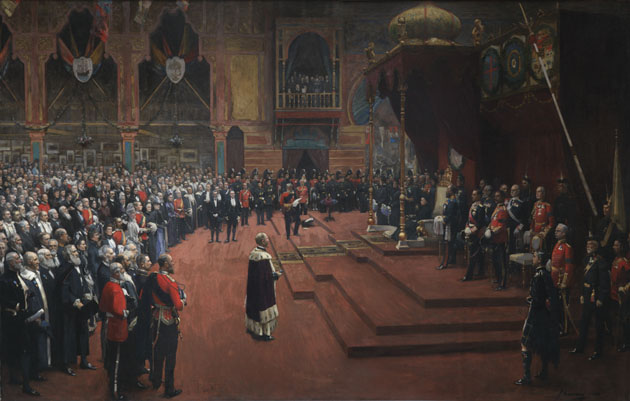Details
- Object type
painting
- Title
State Visit of Her Majesty, Queen Victoria to the Glasgow International Exhibition, 1888
- Artist/Maker
John Lavery artist
- Culture/School
Glasgow Boys
- Place Associated
Scotland, Glasgow, Glasgow International Exhibition (place depicted)
- Date
1890
- Materials
oil on canvas
- Dimensions
framed: 2657 x 4152 mm;unframed: 2565 mm x 4064 mm
- Description
-
Glasgow Boy artist John Lavery was commissioned to paint this grand civic portrait to commemorate the state visit of Queen Victoria to the International Exhibition in Glasgow on 22 August 1888, when she also opened the newly completed Glasgow City Chambers. The exhibition had previously been opened by Prince Edward and Princess Alexandra, the Prince and Princess of Wales, on 8 May 1888. Lavery shows Queen Victoria sitting on a canopied throne on a specially constructed stage in the Grand Hall of the International Exhibition, listening to Sir Archibald Campbell, the President of the Exhibition, delivering his address. She is surrounded by European royalty, the Royal Company of Archers and the Queen’s Own Royal Glasgow Yeomanry. The Lord Provost Sir James King stands at the front in his robes of office. The crowd of people behind him in official uniform and finery include local aristocracy, councillors, business people and industrialists. There are 253 people depicted in total.
Lavery had very little time to prepare for this prestigious and complex painting, the commission only confirmed a week before. He painted behind a curtain on a special platform which was hurriedly constructed and finished on the day of the ceremony. Fellow Glasgow Boy Arthur Melville captured him at work but the whereabouts of his artwork is unknown. On the day Lavery only managed to complete a preparatory study for the painting (Aberdeen Art Gallery). In 1889 he secured further short sittings with Queen Victoria, Princess Beatrice and Prince Henry of Battenberg at Windsor and the Grand Duke of Hesse and his daughter Princess Alix at Darmstadt. He went on to make individual portrait studies of each person in the painting, some in his Glasgow studio, others in William Patrick Whyte’s Primrose Hill Studios in London and others at homes of the sitters. In addition he made use of photography, taking photographs of some sitters and using photographs taken by James Craig Annan on the day. The painting took over two years to complete, receiving final approval from Queen Victoria in December 1890.
Lavery was probably chosen for the commission because of the reputation he had been developing for his portraits and urban subjects; he had won a gold medal at the Paris Salon in 1888 for one of his Glasgow tennis paintings (Aberdeen Art Gallery). Also he and several other Glasgow Boys had painted murals for the main International Exhibition building. More importantly, he had become a kind of painter-in-residence at the exhibition, painting over 50 oils recording the fashionable crowds, craftspeople at work, pavilions, bandstand performances, military parades, fireworks and other entertainments, which he exhibited at Craibe Angus’ Glasgow gallery in October 1888. Lavery was paid only £600 for the royal commission but he made money by selling these and some of his portrait sketches – the remaining 115 unsold studies were offered by Lavery to the Corporation of Glasgow (they entered Glasgow Museums’ collection in 1935 after initial refusal). Lavery also made money exhibiting the finished royal painting before he handed it over to the city. He was paid £1,000 for lending it to the Van Baerle Brothers’ gallery on Sauchiehall Street in December 1890 and £6,000 for allowing it to be shown at Glasgow entrepreneur Walter Wilson’s Colosseum Warehouse. He also exhibited the painting in London at the McLean Gallery in 1891 and had prints made. Royal endorsement made Lavery’s reputation and many lucrative portrait commissions followed, including another royal commission in 1912, The Family of King George V (Royal Collection Trust).
- Credit Line/Donor
Registered, 1893
- ID Number
710
- Location
Kelvingrove Stairs
